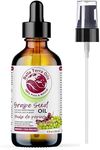Buying Guide for the Best Grapeseed Oils
Choosing the right grapeseed oil can make a big difference in your cooking, skincare, or other uses. Grapeseed oil is popular for its light flavor, high smoke point, and potential health benefits. When shopping for grapeseed oil, it's important to consider how you plan to use it—whether for frying, salad dressings, or as a beauty product. Understanding the key specifications will help you select the best option for your needs.Extraction MethodThe extraction method refers to how the oil is obtained from grape seeds. The two main types are cold-pressed and solvent-extracted. Cold-pressed oils are made by mechanically pressing the seeds without using heat or chemicals, which helps preserve nutrients and results in a purer, more natural oil. Solvent-extracted oils use chemicals to pull the oil from the seeds, which can affect flavor and nutritional value. If you want a more natural product for dressings or skincare, cold-pressed is usually preferred. For high-heat cooking, either type can work, but cold-pressed is often considered higher quality.
Refinement LevelRefinement level describes how much the oil has been processed after extraction. Refined grapeseed oil is filtered and treated to remove impurities, making it lighter in color and flavor, and giving it a higher smoke point. Unrefined oil is less processed, retaining more of its natural flavor and nutrients, but it may have a lower smoke point and a stronger taste. If you plan to use the oil for frying or sautéing, refined oil is a good choice. For salad dressings or skincare, unrefined oil can offer more flavor and potential benefits.
Smoke PointThe smoke point is the temperature at which the oil starts to smoke and break down. Grapeseed oil is known for having a high smoke point, usually between 400°F and 420°F (204°C to 216°C). This makes it suitable for high-heat cooking like frying and roasting. If you mostly use oil for high-temperature cooking, make sure to choose one with a higher smoke point. For low-heat uses or cold applications, the smoke point is less important.
Flavor ProfileGrapeseed oil generally has a mild, neutral flavor, but there can be slight differences depending on how it's processed. Some oils may have a faint nutty or grassy taste, while others are almost flavorless. If you want the oil to blend into dishes without affecting the taste, look for a neutral-flavored oil. If you enjoy a hint of natural flavor, an unrefined or minimally processed oil might be more appealing.
PackagingPackaging refers to the type of container the oil comes in, such as glass or plastic bottles, and whether it is opaque or clear. Glass bottles, especially dark or opaque ones, help protect the oil from light and air, which can cause it to spoil faster. If you plan to use the oil slowly or store it for a while, choose oil in a dark glass bottle for better preservation. For quick use, packaging is less critical, but always store oil in a cool, dark place.
Intended UseIntended use means thinking about how you plan to use the grapeseed oil—cooking, baking, salad dressings, or skincare. Some oils are specifically labeled for culinary or cosmetic use, and may be processed differently. If you want an oil for both cooking and skin care, look for food-grade, cold-pressed options. For only cooking, focus on smoke point and flavor. For skin or hair, purity and extraction method are more important.














